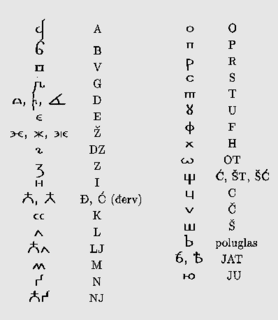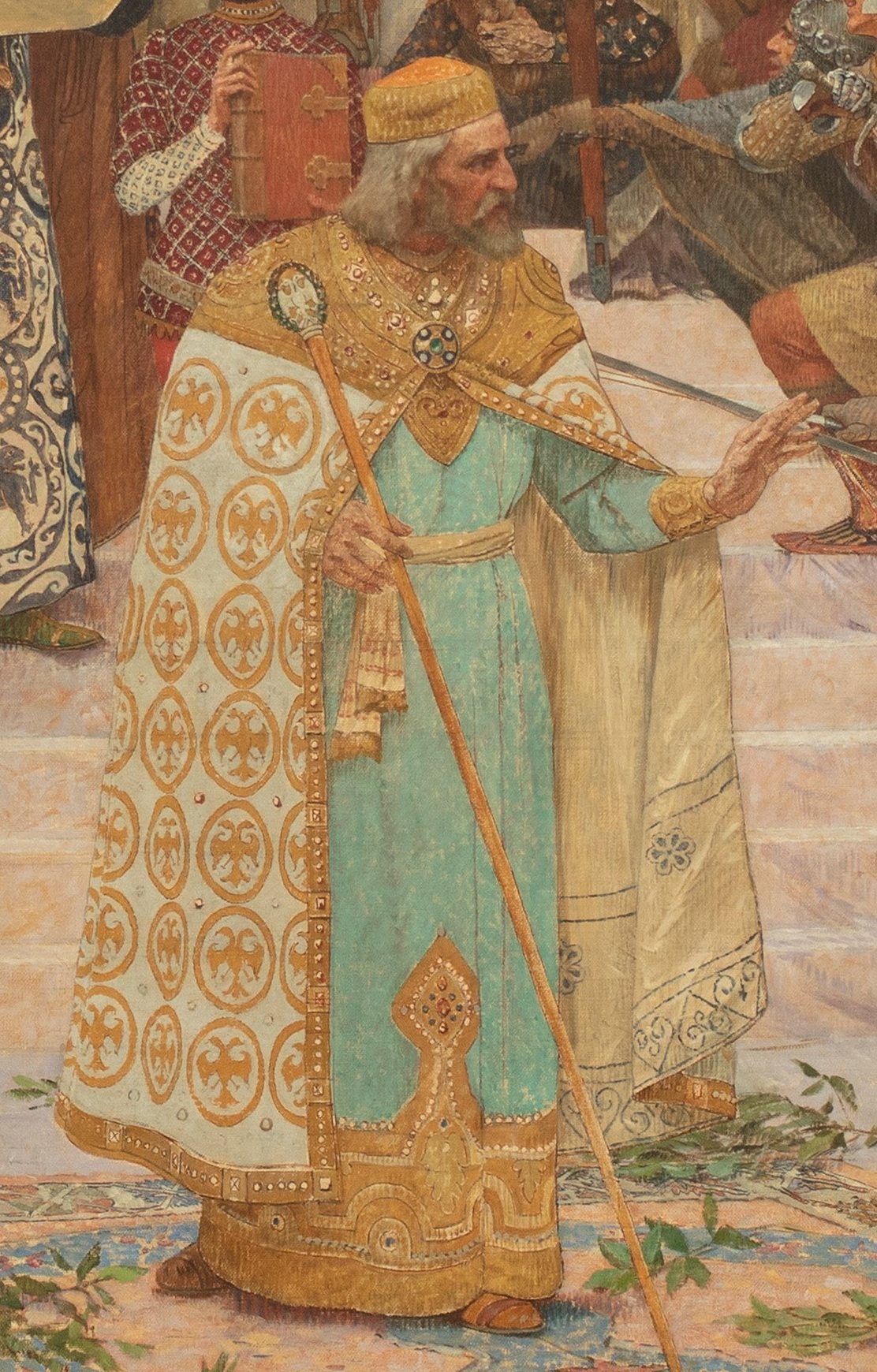Related Research Articles

Bosnian Cyrillic, widely known as Bosančica is an extinct variant of the Cyrillic alphabet that originated in medieval Bosnia. The term was coined at the end of the 19th century by Ćiro Truhelka. It was widely used in modern-day Bosnia and Herzegovina and the bordering areas of modern-day Croatia. Its name in Bosnian-Croatian-Serbian is Bosančica and Bosanica the latter of which can be translated as Bosnian script. Serb scholars call it Serbian script, Serbian–Bosnian script, Bosnian–Serb Cyrillic, as part of variant of Serbian Cyrillic and the term "bosančica" according to them is Austro-Hungarian propaganda. Croat scholars also call it Croatian script, Croatian–Bosnian script, Bosnian–Croat Cyrillic, harvacko pismo, arvatica or Western Cyrillic. For other names of Bosnian Cyrillic, see below.
Viktor Novak, was a Yugoslav historian, professor at the University of Belgrade and full member of the Serbian Academy of Sciences and Arts (SANU), and a corresponding member of the Yugoslav Academy of Sciences and Arts (JAZU).
The Serbian Chancellery, sometimes known as the Slavic Chancellery, was a diplomatical and economical office of several states of Serbia in the Middle Ages in the Republic of Ragusa. It was established in the early 13th century.

Nikola Buća was a Serbian nobleman, merchant from Kotor, and protovestijar in the service of King Stephen Uroš III Dečanski of Serbia and Emperor Stephen Dušan the Mighty.
Hristifor "Risto" Kovačić was historian and teacher. Kovačić's most important writings were on Serbian antiquities. There is much that is striking and original in his history of Serbs in Italy. H
General Vuča or General Vuka is a popular legendary hero of Serbian epic poetry who is depicted as enemy of Kraljević Marko.
Peter Dóczy de Nagylucse was a 15th-century Hungarian nobleman. In 1462 he was a captain of the Belgrade fortress. Around 1479 he was a commander of the Hungarian fleet on Danube in Varadin. In 1480 he was a ban of Jajce in Bosnia.
Svrčin was one of the castles of Nemanjić dynasty, built around 1321, on an island in the artificially made Svrčin lake, northeast from present day Uroševac. The exact location of the medieval Svrčin has not been determined precisely because of a lack archaeological research in the areas in which it is localized, but based on the remains discovered so far, Svrčin was situated between Svrčin hill and present day village Svrčina. It is registered cultural monument under protection of Republic of Serbia from 1967.
Nikola Radonja or Nikola Radonja Branković or Gerasim or Roman, was a 14th-century Serbian nobleman and chronicler, a member of the Branković dynasty as the eldest son of Branko Mladenović. He is remembered as the author of "Gerasim's Chronicle."
Hieromonk Pahomije was a Serbian Orthodox hieromonk and one of the first printers of books in the Serbian language. He learned his printing skills from Hieromonk Makarije at the Crnojević printing house in the period of 1494–96. In 1518 he accepted the invitation of Božidar Vuković and went to Venice where he organized printing at the Vuković printing house in the period of 1519/1520–21.
Matulović is a Serbo-Croatian surname, a patronymic derived from the archaic Slavic given name Matul. It may refer to:
Petar Petretić was a historian, linguist, and Catholic bishop of the Roman Catholic Archdiocese of Zagreb (1648–1667).

The Eparchy of Marča was a Eastern Christian ecclesiastical entity taking two forms in the 17th century: an Eastern Orthodox eparchy and an Eastern Catholic vicariate. The term was derived from the name of the monastery at Marča near Ivanić-Grad, Habsburg Monarchy.
Rafael Levaković, O.F.M. was a Franciscan prelate who served as Archbishop of Achrida (1647–1650); and Glagolitic writer who set foundations for Slavic liturgy based on the missionary concept of the Roman Catholic Church. Levaković actively worked on religious conversion of the Orthodox Serbs in Croatia.
Martin Dobrović or Martin Dubravić (1599–1621) was a Catholic priest. After finishing his education in Graz, he became parson of Ivanić Grad and later became a canon in the Roman Catholic Archdiocese of Zagreb.
Simeon Vratanja was the first bishop of the Eparchy of Vretanija (1609–11), the westernmost eparchy of the Serbian Patriarchate of Peć, and the first bishop of the Eastern Catholic Bishopric of Marča (1611–28).

The South Slavic Bible Institute was established in Urach in January 1561 by Baron Hans von Ungnad, who was its owner and patron. Ungnad was supported by Christoph, Duke of Württemberg, who allowed Ungnad to use his castle of Amandenhof near Urach as a seat of this institute.
Albert Pessler (1590–1629) was 17th-century provost of Patriarchate of Aquileia.
General Petar Terzić also spelled Peter Tersich von Cadesich was an Austrian nobleman, major general who fought in both the Ottoman and Napoleonic wars.
General Petar Terzić also spelled Peter Tersich von Cadesich(Serbian: Генерал Петар Терзић; Kovilj, Slavonia, Habsburg Monarchy, 1739 - Pančevo, Banat, Habsburg Monarchy, 22 December 1806) was an Austrian nobleman, major general who fought in both the Ottoman and Napoleonic wars.
References
- ↑ Badurina 2001, p. 153.
- 1 2 Matica 1880, p. 733.
- 1 2 3 4 Kudelić 2007, p. 145.
- ↑ Književnost 1996, p. 1417.
- ↑ umetnosti 1950, p. 60.
- 1 2 umetnosti 1950, p. 65.
- ↑ Петровић 2006, p. 449.
- ↑ Glasnik 1912, p. 283.
- ↑ Bassett 1967, p. 47.
- ↑ Basiliani 1975, p. 49.
- ↑ Nazor 2008, p. 127.